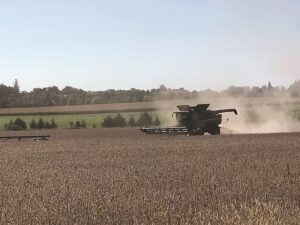Weed management
INCREASING YIELDS AND PROFITS

ACCORDING TO DR. PETER SIKKEMA, careful weed management in soybeans can increase yields and profits while bringing an astonishing 344 per cent return on investment (ROI).
“My goal is to incrementally advance the science of weed management — hopefully to improve the information for Ontario farmers every year so they get better weed control, decrease soybean yield loss due to weed interference and increase net returns,” says the professor of weed management at the University of Guelph’s Ridgetown campus who has been conducting research for 30 years.
In his most recent research, partly funded by Grain Farmers of Ontario, Sikkema has found that a two-pass strategy is the most profitable most of the time, not only for soybeans but also for corn and dry beans.
He explains that by using an effective soil- applied herbicide followed by a post-emergent herbicide to control weed escapes, growers are using multiple herbicide modes of action over time, which reduces the likelihood of resistant weeds gaining a foothold in the field.
He advises growers to adjust their weed management program on a field-by-field basis because the herbicides’ effectiveness depends on soil characteristics, weed species, weed density, and what will be planted in the field next season.
For soil-applied herbicides, he says, good records from previous seasons are a must so that the grower knows what weeds are typically present in each individual field.
RESISTANT WEEDS
Glyphosate-resistant weeds have been the focus of Sikkema’s research for half of his career.
In 2008, glyphosate-resistant giant ragweed was confirmed in Ontario, Canada fleabane in 2010, common ragweed in 2011, and waterhemp followed in 2014.
“The presence of glyphosate-resistant and multiple herbicide-resistant weeds has increased the complexity of weed management for Ontario farmers,” he says.
Sikkema says that the proliferation of herbicide-resistant weeds is a result of changes in weed management practices across North America.
“With the introduction of Roundup Ready soybean in 1997, and corn in 2001 and the concomitant repeated use of glyphosate has resulted in the selection of glyphosate- resistant biotypes,” he says.
He thinks that the rise of these herbicide- resistant weeds is a result of a combination of weed management on the farms and the movement of the resistant biotypes, whether by wind (fleabane) or on equipment like cultivators, planters, and combines.
“Generally, for an individual field, we really don’t know how the herbicide-resistant biotype got there; however, we do know it’s ending up in more and more fields across the province,” he says.
In fact, glyphosate-resistant Canada fleabane and waterhemp are present across southern Ontario, and herbicide-resistant common ragweed has been found in pockets throughout southern Ontario.
HIGH COST OF NOT CONTROLLING WEEDS
In his presentation on weed management in soybeans, Sikkema shows the results of research conducted between 2017 and 2021
in 336 field trials at Exeter and Ridgetown. With no weed control, soybean yield losses were a full 35 per cent.
Using Ontario Ministry of Agriculture, Food and Rural Affairs crop statistics for 2018 to 2021, that loss would have resulted in an eye-popping $700 million loss at the farm gate to Ontario growers.
According to his research, having a post- emergent-only herbicide program can also be costly. Basically, the higher the weeds grow before applying herbicides, the greater the yield and monetary losses. Research shows that letting weeds grow from two to four inches in height in fields with heavy weed pressure means a two- bushel per acre loss per inch of weed height.
His data shows that with 1,000 acres of soybean at a market price of $13.59 per bushel, letting weeds grow to two inches in this environment results in a loss of $24,590. If they get to six inches, the loss is nearly $113,000.
While many growers may be tempted to wait until all the weeds have emerged, the two-pass strategy of starting clean and staying clean through the critical weed-free period results in improved weed control and higher net returns for growers in many situations.
USE OF ADJUVANTS
“With some postemergence herbicides, sometimes the addition of an adjuvant is not required; in contrast, sometimes they can have a dramatic effect on weed control, soybean yield, and net returns,” Sikkema says.
In one example, he showed that increasing the rate of Roundup on soybeans produced basically the same yield results as adding an adjuvant to the Roundup.
In another example involving a soybean crop planted after corn, he showed that adding an adjuvant to Select improved volunteer corn control by about 75 per cent and increased yield by an average of eight bushels an acre. Assuming increased gross returns of $109 per acre and a $3 per acre cost of the adjuvant, Sikkema calculated an astonishing 3,624 per cent return on investment.
He says that making the choice comes down to knowing each herbicide’s active ingredient and whether or not there’s a benefit to adding an adjuvant to the herbicide.
“It’s about finding the optimal adjuvant to add to the herbicide,” he says, emphasizing the importance of growers reading the herbicide label and using the adjuvant on the label.
Even then, results may vary based on the water source, environmental conditions, the weed species, and the weed size at application.
“On average, across a range of weed species, environmental conditions, and weed sizes at the time of application, the adjuvant that appears on the label will be the best,” he says.
On a final note, Sikkema says that a perfectly clean soybean field at harvest doesn’t necessarily mean the best crop/ weed management. He says two 50-acre fields may look exactly the same at harvest. One has undergone the two-pass strategy with nearly no weeds, and the other has had early-season weed interference, causing a three-bushel-per-acre yield loss and a loss of about $45.00 an acre.
So, where does the ROI of 344 per cent as a result of good weed management come from? Taking an average yield of 49.5 bushels per acre, selling at $13.59 per
bushel, losses due to weed interference would amount to $236.60 per acre, while the cost of weed management would be $68.69 per acre. •











